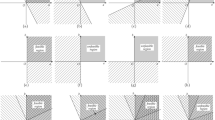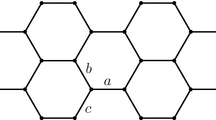Abstract
The aim of this paper is to give an explicit computation for the potential generated by a dipole on a hexagonal grid. Such a computation will be expressed as the Fourier transform of a distribution on the bidimensional torus\(\mathbb{T}^2 \).
Similar content being viewed by others
References
R. Courant, K. Friedrichs, and H. Lewy, über die partiellen Differenzengleichungen der mathematischen Physik,Math. Ann. 100 (1928), 32–74.
P. G. Doyle and J. L. Snell, Random walks and electric network, Mathematical Association of America, Washington D.C., 1984.
R. J. Duffin, Discrete potential theory,Duke Math. J. 20 (1953), 233–251.
R. E. Edwards,Fourier Series—A Modern Introduction, vol. II, Holt, Rinehart and Winston, New York, Chicago, San Francisco, Atlanta, Dallas, Montreal, Toronto, London, 1967.
H. Flanders, Infinite networks I—Resistive networks,IEEE Trans. Circuit Theory CT-18 (1971), 326–331.
—, Infinite networks II—Resistance in infinite grid,J. Math. Anal. Appl. 40 (1972), 30–35.
W. H. McCrea and F. J. W. Whipple, Random path in two and three dimensions,Proc. Roy. Soc. Edinburgh 60 (1940), 281–298.
C. Melzi, Computing potentials on a periodic bidimensional grid,Circuits Systems Signal Process.15 (1996), 519–527.
E. Schlesinger, Infinite networks and Markov chains,Boll. Un. Mat. Ital. 6-B (1992), 23–37.
P. M. Soardi, Potential theory on infinite networks,Lecture Notes in Math., vol 1590, Springer-Verlag, Berlin, Heidelberg, New York, 1994.
P. M. Soardi and W. Woess, Uniqueness of current in infinite resistive networks,Discrete Appl. Math. 31 (1991), 37–49.
F. Spitzer,Principles of Random Walks, Van Nostrand, Princeton, NJ, 1964.
A. Stöhr, über einige lineare partielle Differenzengleichungen mit konstanten Koeffizienten I,Math. Nach. 3 (1950), 202–242;III,Math. Nach 3 (1950), 330–357.
B. Van der Pol, The finite difference analogue of the periodic wave equation and the potential equation,Probability and related topics in physical sciences (Appendix IV) (M. Kac, ed.), Interscience, London, 1959.
A. H. Zemanian, Infinite electrical networks,Proc. IEEE 64 (1976), 6–17.
—,Infinite Electrical Network, Cambridge University Press, Cambridge, U.K, 1991.
A. H. Zemanian and P. Subramanian, A theory of undergrounded grids and its applications to the geophysical exploration of layered strata,Studia Math. 77 (1991), 162–181.
Author information
Authors and Affiliations
Rights and permissions
About this article
Cite this article
Melzi, C. Potentials on the hexagonal grid. Circuits Systems and Signal Process 16, 405–414 (1997). https://doi.org/10.1007/BF01198058
Received:
Revised:
Issue Date:
DOI: https://doi.org/10.1007/BF01198058




